7 Bizarre Advances in Animal Cyborg Technology

If there are two things the Internet loves, it's cute, fuzzy animals and deadly cyborgs. As awesome as those two things are on their own, though, combining them gives us something that's often more disturbing and insane than either of those could bring us on their own.
Ah, science. Apparently, we won't learn until Terminator badgers and RoboCop narwhals take over the world.
Leech Brain Computers

Here's a question for you: If the human brain is way faster and more efficient than a computer many times its size, why aren't we devoting our time to trying to design artificial, organic brains instead of computers? If your answer is that the result would be a superintelligent, unpredictable monstrosity that would quickly take over the Earth, well, that's probably the reason.

Science: bringing nightmares to life.
But science, oh glorious science, couldn't resist the temptation forever and is already taking steps toward creating an organic thinking machine. In 1999, scientists at Georgia Tech created a computer able to do basic computations, and they made it out of a leech's brain.

Yes, a leech. It will be a blood-drinking robot.
What Were They Thinking?
Since this is fairly uncharted territory, the eggheads figured they'd better start small. The robo-leech is only able to do simple calculations, but it's still a solid first step into bio-organic computer components. In the decade since, scientists have continued research into making living things into computer parts. Take, for example, the gold-plated microbes that scientists built to act as humidity sensors in moisture-sensitive equipment. They're four times more accurate at detecting moisture than solely electronic sensors.

We're not even to the creepy (or is it creepiest?) part of this whole scheme. They built this thing specifically so it could think for itself and, if it didn't know the answer to a question, to figure it out for its damn self. According to one of its creators, "Ordinary computers need absolutely correct information every time to come to the right answer. We hope a biological computer will come to the correct answer based on partial information, by filling in the gaps itself."
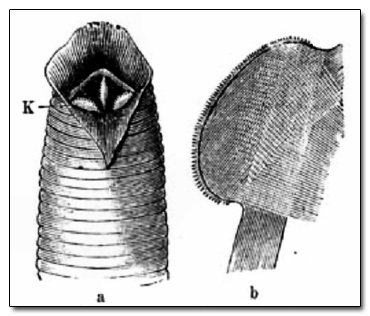
Yeah, that makes sense.
We won't have to worry about rogue A.I.s becoming sentient one day if they're already living, thinking things. Then it's just a certainty.
Chemical Detectors Made From Living Animal Parts

As humans, we don't have very good senses of smell. For example, you can slowly get used to the funk of your unwashed body and then you can honestly say, "I don't know why everyone's complaining, I can't smell a thing." It works. Possibly even in a court of law. Trust us.

"Does anyone smell that? You don't?"
This is why we need animals to do our really important smelling tasks for us, like with bomb-sniffing dogs. They're great at it, and they get those bulletproof vests that make them just look adorable.

Aw, who's a good justice-loving doggie? Yes you are!
But you think science is going to stop there? Shit, no! That's why it's time for supersmelling machines made out of bees. Or frog guts. Obviously.
What Were They Thinking?
See, the problem with dogs is you have to train each dog individually, and most dogs are only trained to sniff out just a few scents at a time. So what if you need, say, 30 some-odd chemicals sniffed out at once? The answer is bees. Bees have noses that are just as good as a dog's, but they're much easier and faster to train. They can only be trained to respond to one scent at a time, but they're small enough that you can keep a bunch of them in a small space. Enter the VASOR136.

It's like the bastard child of a hand vac and a Ghostbusters containment device.
It's a device that holds tiny cartridges filled with bees. Bee cartridges. Each bee is attuned to a specific scent like meth or TNT and, when they smell it, they respond by extending their proboscis, just like bees normally do when they smell nectar. The device detects that and, voila, the scent has been detected. (Also, the bees are let go afterward. You don't just leave them in there or anything.)
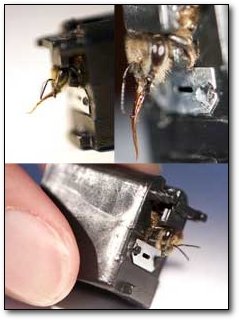
That's interesting, because AAAAAAAAAHHHHHHH!
But if you're looking for the next level shit, some Japanese scientists have got what you need. They took the scent receptor cells from an African clawed frog, genetically modified them to work like an insect's, and put them in a portable device. They say the frog cells worked better because they were big enough to individually manipulate, but we think that they probably just had too many frogs laying around or something.
Craziest of all, though, is that they actually mounted the thing to a robot and their report gives instructions on just how they did it. That's great for all of you who thought you could hide from a robot uprising, or cover yourself in mud to hide from their infrared sensors. Don't worry, their super sense of smell will find you just fine.
Cyborg Rats Will Save Your Life

Not that these projects all have to be harbingers of the apocalypse. Some of them could actually be helpful in said apocalypse.

We're envisioning some sort of robotic Saint Bernard with a keg in its chest and the ability to vomit hand grenades.
Say you're trapped under rubble. Aliens have just attacked, and with half the continent still smoking from UFO-related fire, you find yourself deep under a large pile of collapsed debris. Your situation seems pretty hopeless. Unless, of course, there was some kind of computerized rat with, we don't know, a proton pack on its back that could sniff you out and send your location to rescue teams.
Good news! We have the prototypes right now.
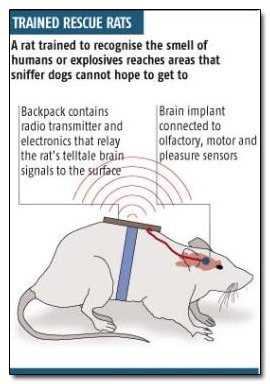
We're not far from the day when rats will be able to track you based on your phone's GPS signal.
What Were They Thinking?
Dogs and bees and horrific frog cyborgs aren't the only ones good at sniffing. Rats are, too, it turns out. Also, if you haven't heard, there are tons of rats, especially if you live in a big city. Some cities have gone to extreme lengths to deal with their rat problems, and the things just won't leave. They're going to end up regretting that if they go through a natural disaster, though, because it turns out that rats are totally amazing at finding trapped people.
Since rats are tiny, love to explore small nooks and crannies, and have great senses of smell, DARPA and the University of Florida have devised a system that uses rats for disaster relief. The rats are trained to sniff out humans, find them, and then report it to the scientists monitoring them. How do they do that last part? Simple -- the rats have a tiny backpack that transmits all its thoughts using radio waves. It's like rat brain Twitter.

The device reads the olfactory and motor control portions of the rat's brain and sends it straight to the scientists monitoring the little guy. On top of that, they're tapped into the rat's pleasure center, so they can give the rat a little happy juice for a job well done.

But how long until the rats cause their own disasters just for a few hits off the joy button?
Downloadable Cat Memories

Ever stepped out of the shower and found your cat staring at your junk and silently judging you? Well, in the future, Mr. Kitty McMeowcat may not be the only one getting an eyeful of your shame.

"Oh that is ... wow. Just, wow."
In short, science has in essence made a literal "seeing eye cat" (not that there's any version of a seeing eye cat in reality, but go with it for a sec) in that they can hook up a brain machine and, from a monitor, see what the cat sees. It can tell us how cats receive and process images, not to mention how they respond to being fused with a brain machine. And some day, they may be able to do it with you.

"Man, delivering pizzas would be way more fulfilling if I was a cyborg."
What Were They Thinking?
Back in the storied year of 1999, while we watched The Matrix (and wondered how awesome the sequels would be) and partied as Prince had advised us, scientists at the University of California at Berkeley were conducting a little experiment. Prof. Yang Dan tapped into the cat's thalamus, the part of the brain that receives images from the eyes. After hooking the cat into a really uncomfortable-looking device and forcing it to watch video clips of things such as Indiana Jones, they began decoding the cat's vision and examining it.

Surprise! You look just like a big cat to them!
The idea behind the project is to slowly learn how the mammalian brain actually processes images. They did discover one really cool thing: What comes into the thalamus from the eyes is a very raw image, and the brain's higher functions actually kind of Photoshop it into something clearer. They intend to eventually test it on humans to try and come up with new ways to get around blindness and other disabilities, too.
An especially chilling note is in the speculation over future uses of the technology, though: "It is also conceivable that, given time, it will be possible to record what one person sees and 'play it back' to someone else either as it is happening or at a later date."

That's right: James Cameron is a goddamn prophet.
Someday, cats might be able to make adorable cat videos of themselves. No humans sitting around with cameras and laughing like goobers required. All they'd need for worldwide domination is the ability to have them automatically upload to YouTube.
Animal Mind-Control Machines

Probably every cartoon villain ever invented some mind-control caps, and why not? What better way to get people to do your bidding than to just not give them any other choice? It's a perfect villain scheme.

Unless you're using it for sexual assault purposes, anyway.
On a probably unrelated note, scientists at Stanford have discovered that they can use colored lights to control the minds of mice. It's a field called optigenetics -- using light to control the mind. They were able to attach a device into the mice's brains so that when a blue light was shone on it the mice would run in a counter-clockwise circle.
Watch the video until about :20 seconds in, when that mouse totally realizes that he has no clue why that just happened:
Harvard, not to be outdone by their Ivy-League rivals, took it a step further and created a system that allowed them to cause roundworms to travel in various directions, stop completely, or even lay eggs on command.
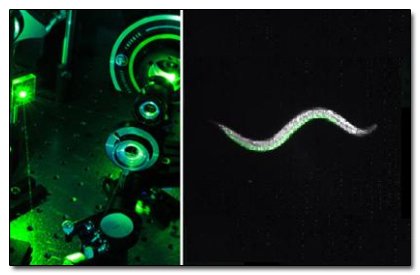
Singularity Hub
Laser-controlled worms will be the hit toy of Christmas, 2019.
But then Oxford University blew both of them away when they went Total Recall on some flies and gave them false memories of a bad experience they never actually had.
What Were They Thinking?
You may be wondering what the point of all this research is, besides terrifying small animals. The fact is, optigenetics could be one day used to re-program the human brain to help people with brain diseases like Parkinson's. It may even potentially be able to accurately control prosthetic limbs as though they were real. Because, you see, the ultimate goal of optigenetics is two-way communications. That is, they want to be able to both read your mind as well as writing to it. According to those familiar with this whole ridiculous undertaking, "In theory, two-way optogenetic traffic could lead to human-machine fusions in which the brain truly interacts with the machine, rather than only giving or only accepting orders."

Which sounds an awful lot like "collaboration with our robot enemies" to us.
From there, it's only a matter of time before some mad scientist creates mind-controlled bears to round up his future human slaves.

"You're going to have to come with me, sir."
Titanium Tooth Dogs and a Cyborg Eagle

During the recent assault on Osama Bin Laden's compound, reports came out that the Navy SEAL team used dogs and that they had been fitted with titanium teeth. There are even photos of this badassery, like this one from the Telepgraph:

And this one from Greg Eichelberger's Flickr:

But while America is busy upgrading its animals, what about the national symbol? Bald eagles are so cool that America sticks them on everything. You can't whip out a dollar bill without seeing a picture of an eagle looking like it means goddamn business.
Of course they're not perfect. Something is definitely missing, and that something is a titanium beak. Fortunately, science is on it.

"Also, give it a chainsaw tail."
What Were They Thinking?
The doggie tooth replacement isn't done to make them more lethal -- it's done as a repair when the dog breaks a tooth or has some other dental problem. The dogs are expensive to train, and it's worth it to do expensive dental work rather than send them off to retirement.
As for the eagle, again it wasn't a plot to create a more perfect eagle killing machine -- it was all in the name of helping a wounded bird. We're sorry that not every example on this list hints at a horrifying future of enslaved humanity.
The situation here is that Beauty the bald eagle was found in 2005 with her upper beak shot off by a poacher and left to slowly starve. Bald eagles obviously need their beaks, not just to hold and eat food, but to preen their feathers, which is a big deal for flight. So mutilating a bird like that is pretty much condemning it to die. Luckily, this particular eagle was rescued by a group called Birds of Prey Northwest who rehabilitated her and, in 2008, they fitted her with a her new beak made out of titanium, because we're assuming adamantium was not readily available.

Thanks for nothing, adamantium hog.
As cool as titanium is, it's actually just a temporary fix. They're planning on replacing it later with something even stronger.
The Birds of Prey aviary where Beauty is currently located has decided not to release her back into the wild, saying that she's spent too long around humans now and that any prosthetic beak would never be a perfect replacement, but we like to think that they know the truth: If Beauty ever made it back into the wild, she'd hunt down that poacher, Kill Bill-style, and screw him straight up.

Which she'll be able to do thanks to the eye lasers they're adding.
Robots With Animal Brains

Hey, remember when we said earlier that scientists had made strides creating a primitive organic brain? Well some of you immediately thought, "Yeah, sure, but that's not going to truly rule until we can stick that brain into a robot body. How else will it kill us?"

Separation anxiety will soon involve servos and burning your house down with lasers
Don't worry, science is on the case! And we're not talking about theoretical shit, either. Robots that use animal brains is totally a thing now.
What Were They Thinking?
Probably just to see if they could, in 2001, scientists at Northwestern University built a hockey-puck shaped robot controlled by an immature Lamprey eel's brain. (We like to think that by immature, they mean it giggles when it hears the word "poop.") It even has little wheels on it, which it uses to follow lights that scientists shine on it, like a cat playing with a laser pointer.
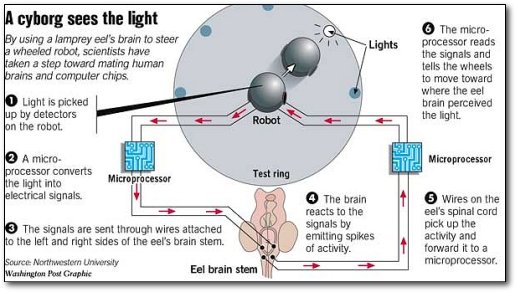
Via sfgate.com
Explained in this comprehensive chart
In 2008, researchers at Reading University did something similar, building a wheeled robot controlled by a soup of rat neurons. They even made a video.
You're welcome. The little guy(s) was /were able to avoid obstacles, navigate around freely, and generally be an affront to all that God ever intended for this world and our race.
And then, in 2009, the final step into madness was reached. Japanese scientists built a robot that is controlled by a moth's brain. But this brain is special, you see, because the moth is freaking dead and its severed head controls the monstrosity.
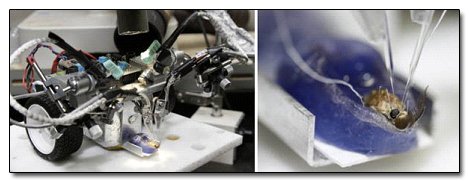
WHAT HAVE YOU DONE?
Somehow, probably through some sort of deranged alchemy, the scientists managed to get the moth's antennae and brain to continue functioning even after death. The antennae receive scent information from the air and transmit it to the moth's zombified brain, which the robot reads and uses to move around. What, you thought that we were building up to the prospect that some day science would build a robot using a human brain? Fuck that. They want a robot driven by a zombie brain.
To read more of Ashe's work, check out weirdshitblog.com and Bad Metaphors.
For more ways we've messed with animals, check out 7 Insane Military Attempts To Weaponize Animals and 6 Animals Humanity Accidentally Made Way Scarier.